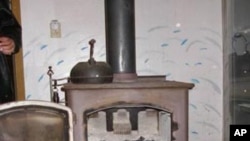An international team of scientists says global warming can be slowed in the short term by focusing less on carbon dioxide and more on the emission of methane and soot.
Carbon dioxide emissions produced by burning fossil fuels are the major cause of global warming, so efforts to combat climate change have focused on ways to cut CO2 releases. But according to the new study published this week in the journal Science, a quicker and more effective strategy would be to reduce emissions of other, shorter-lived air pollutants. The measures would not just slow climate change, but also boost crop yields, save money, and save lives.
Once CO2 is released into the atmosphere, it remains there for decades, while other global-warming pollutants such as methane and black carbon, or soot, do not. Soot is a byproduct of inefficient burning, a big problem in developing countries with cook stoves using wood, dung or coal. Soot stays in the air for only a few days. Methane, a gas released from landfills, farms, mines and natural gas wells, stays in the atmosphere for about a decade.
Researchers analyzed 2,000 existing pollution control measures for the two pollutants to determine which would be most effective in both slowing global warming and cleaning up the air.
Drew Shindell, a climate scientist with NASA, the U.S. space agency, led the analysis. In an interview with the journal Science, he pointed to the control measures that ranked at the top of the list.
For methane, he said, that means “… capturing leaks from pipelines and storage tanks, capturing instead of either releasing or flaring off methane that is produced naturally in coal mining, and in oil and gas production, and capturing methane from city landfills.
Measures to reduce black carbon, also known as BC, focused largely on controlling soot emissions from diesel engines and switching to cleaner burning cook stoves.
“So regions where you are reducing BC [black carbon], where the sources are especially large in Asia, especially south Asia and also parts of Africa, those regions would tend to see the greatest benefits in both local reduction of warming and in public health,” Shindell said.
Adopting such controls could avoid between 700,000 and 4.7 million premature deaths, the study estimates, and save one-third of a million lives in India and China alone.
Shindell said the measures are cost effective. For example, profits from captured methane from a mining operation or landfill could boost the economy and protect public health.
“Typically the benefits [come from] reduced damage to agriculture and to health," he said. "And if you value the climate benefits as well, these more than offset the cost. If you invest $50 million and get $70 million back, we think it’s a great idea.”
Control measures would also increase the annual yields of major crops by as much as 135 million metric tons. And Shindell said other effects would begin immediately.
“So for something like black carbon, one of the things that it will do is disrupt the hydrologic cycle," he said. "So as soon as you stop emitting it, the same week, the atmosphere responds and you would have a educed disruption of rainfall patterns, staring virtually immediately.”
Under the methane and black carbon reduction scenario, the study predicts fewer droughts in southern Europe and parts of Africa, and less severe monsoons in Asia. And implementing this strategy could shave a half degree off the expected 1.2 degree Celsius rise in global mean temperature now expected over the next four decades.
Shindell says that while carbon dioxide emissions must be addressed in the long-term, these short-term measures that impact both climate change and public health are worth taking now.
Study: Slow Global Warming by Cutting Soot, Methane







